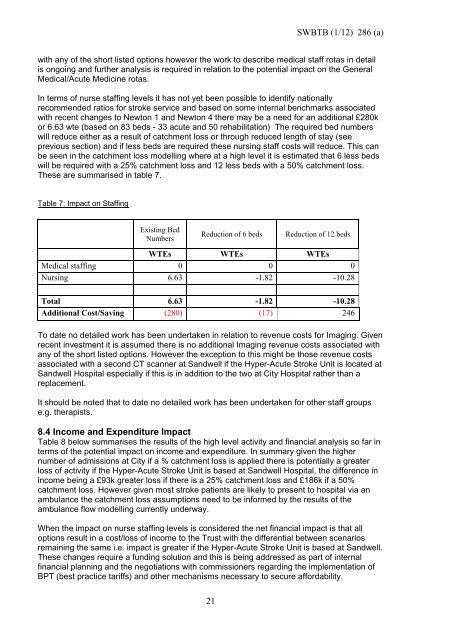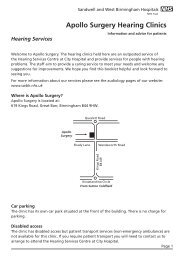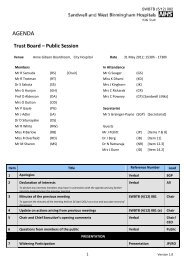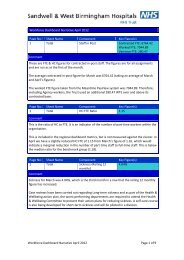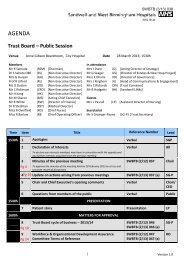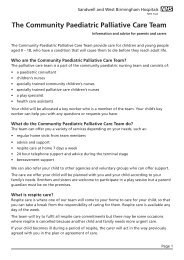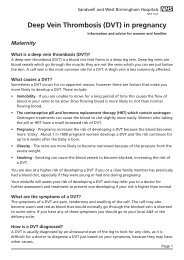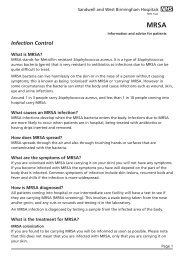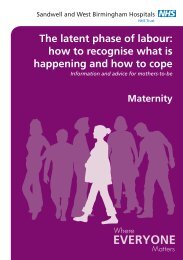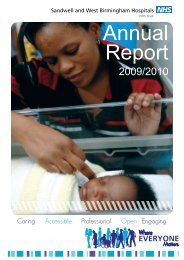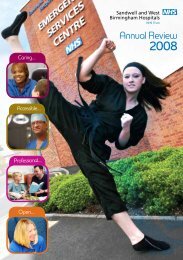January 2012 - Sandwell & West Birmingham Hospitals
January 2012 - Sandwell & West Birmingham Hospitals
January 2012 - Sandwell & West Birmingham Hospitals
You also want an ePaper? Increase the reach of your titles
YUMPU automatically turns print PDFs into web optimized ePapers that Google loves.
SWBTB (1/12) 286 (a)<br />
with any of the short listed options however the work to describe medical staff rotas in detail<br />
is ongoing and further analysis is required in relation to the potential impact on the General<br />
Medical/Acute Medicine rotas.<br />
In terms of nurse staffing levels it has not yet been possible to identify nationally<br />
recommended ratios for stroke service and based on some internal benchmarks associated<br />
with recent changes to Newton 1 and Newton 4 there may be a need for an additional £280k<br />
or 6.63 wte (based on 83 beds - 33 acute and 50 rehabilitation) The required bed numbers<br />
will reduce either as a result of catchment loss or through reduced length of stay (see<br />
previous section) and if less beds are required these nursing staff costs will reduce. This can<br />
be seen in the catchment loss modelling where at a high level it is estimated that 6 less beds<br />
will be required with a 25% catchment loss and 12 less beds with a 50% catchment loss.<br />
These are summarised in table 7.<br />
Table 7: Impact on Staffing<br />
Existing Bed<br />
Numbers<br />
Reduction of 6 beds<br />
Reduction of 12 beds<br />
WTEs WTEs WTEs<br />
Medical staffing 0 0 0<br />
Nursing 6.63 -1.82 -10.28<br />
Total 6.63 -1.82 -10.28<br />
Additional Cost/Saving (280) (17) 246<br />
To date no detailed work has been undertaken in relation to revenue costs for Imaging. Given<br />
recent investment it is assumed there is no additional Imaging revenue costs associated with<br />
any of the short listed options. However the exception to this might be those revenue costs<br />
associated with a second CT scanner at <strong>Sandwell</strong> if the Hyper-Acute Stroke Unit is located at<br />
<strong>Sandwell</strong> Hospital especially if this is in addition to the two at City Hospital rather than a<br />
replacement.<br />
It should be noted that to date no detailed work has been undertaken for other staff groups<br />
e.g. therapists.<br />
8.4 Income and Expenditure Impact<br />
Table 8 below summarises the results of the high level activity and financial analysis so far in<br />
terms of the potential impact on income and expenditure. In summary given the higher<br />
number of admissions at City if a % catchment loss is applied there is potentially a greater<br />
loss of activity if the Hyper-Acute Stroke Unit is based at <strong>Sandwell</strong> Hospital, the difference in<br />
income being a £93k greater loss if there is a 25% catchment loss and £186k if a 50%<br />
catchment loss. However given most stroke patients are likely to present to hospital via an<br />
ambulance the catchment loss assumptions need to be informed by the results of the<br />
ambulance flow modelling currently underway.<br />
When the impact on nurse staffing levels is considered the net financial impact is that all<br />
options result in a cost/loss of income to the Trust with the differential between scenarios<br />
remaining the same i.e. impact is greater if the Hyper-Acute Stroke Unit is based at <strong>Sandwell</strong>.<br />
These changes require a funding solution and this is being addressed as part of internal<br />
financial planning and the negotiations with commissioners regarding the implementation of<br />
BPT (best practice tariffs) and other mechanisms necessary to secure affordability.<br />
21


